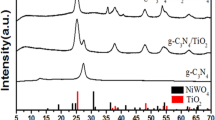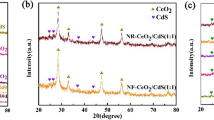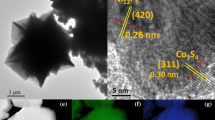Abstract
Photocatalysis, as one of the most advanced oxidation techniques, has been paid more and more attention due to its advantages in solving environmental pollution problems, such as low cost, eco-friendly, efficiently and no secondary pollution. In this paper, we fabricated a series of Ce doped CoIn2S4 photocatalyst with different Ce content via solvothermal reaction and explored the influence of Ce on the photocatalytic activity of CoIn2S4. The properties of all samples were characterized by X-ray diffractometer (XRD), scanning electron microscope (SEM), ultraviolet spectrophotometer (UV–vis), transmission electron microscope (TEM) and so on. The results show that the do** of Ce can highly improve the photocatalytic activity of CoIn2S4. When CoIn2S4 is doped with 0.1 g of Ce(NO3)3·6H2O, it exhibits the highest photocatalytic activity and can degrade 98.55% of rhodamine B (RhB). This strategy of do** rare earth element on semiconductor provides a facile and promising way to the remediation of environmental pollution.

Graphical abstract









Similar content being viewed by others
References
Asif M, Muneer T (2007) Energy supply, its demand and security issues for developed and emerging economies. Renew Sust Energ Rev 11:1388–1413
Rojas S, Horcajada P (2020) Metal-organic frameworks for the removal of emerging organic contaminants in water. Chem Rev 16:8378–8415
Anumol T, Merel S, Clarke BO, Snyder SA (2013) Ultra high performance liquid chromatography tandem mass spectrometry for rapid analysis of trace organic contaminants in water. Chem Cent J 7:104
Pal A, Gin KYH, Lin AYC, Reinhard M (2010) Impacts of emerging organic contaminants on freshwater resources: Review of recent occurrences, sources, fate and effects. Sci Total Environ 408:6062–6069
Qu R, Li C, Liu J, **ao R, Pan X, Zeng X, Wang Z, Wu J (2018) Hydroxyl radical based photocatalytic degradation of halogenated organic contaminants and paraffin on silica gel. Environ Sci Technol 52:7220–7229
Franz TP, Eisenreich SJ, Swanson MB (1991) Evaluation of precipitation samplers for assessing atmospheric fluxes of trace organic contaminants. Chemosphere 23:343–361
Semple KT, Doick KJ, Wick LY, Harms H (2007) Microbial interactions with organic contaminants in soil: Definitions, processes and measurement. Environ Pollut 150:166–176
Robert B, Nallathambi G (2021) Indoor formaldehyde removal by catalytic oxidation, adsorption and nanofibrous membranes: a review. Environ Chem Lett 19:2551–2579
Boltersdorf J, Forcherio GT, McClure JP, Baker DR, Leff AC, Lundgren C (2018) Visible light-promoted plasmon resonance to induce “hot” hole transfer and photothermal conversion for catalytic oxidation. J Phys Chem C 122:28934–28948
Liu R, Huang H, Li H, Liu Y, Zhong J, Li Y, Zhang S, Kang Z (2014) Metal nanoparticle/carbon quantum dot composite as a photocatalyst for high-efficiency cyclohexane oxidation. ACS Catal 4:328–336
Zhou X, Wu S, Li C, Yan F, Bai H, Shen B, Zeng H, Zhai J (2019) Piezophototronic effect in enhancing charge carrier separation and transfer in ZnO/BaTiO3 heterostructures for high-efficiency catalytic oxidation. Nano Energy 66:104127
Liu L, Hu T, Dai K, Dai J, Zhang J, Liang C (2021) A novel step-scheme BiVO4/Ag3VO4 photocatalyst for enhanced photocatalytic degradation activity under visible light irradiation. Chin J Catal 42:46–55
Huang S, Chen C, Tsai H, Shaya J, Lu C (2018) Photocatalytic degradation of thiobencarb by a visible light-deriven MoS2 photocatalyst. Sep Purif Technol 197:147–155
Chen Q, Wu S, **n Y (2016) Synthesis of Au-CuS-TiO2 nanobelts photocatalyst for efficient photocatalytic degradation of antibiotic oxytetracycline. Chem Eng J 302:377–387
Mirzaeifard Z, Shariatinia Z, Jourshabani M, Darivishi SMR (2020) ZnO photocatalyst revisited: effective photocatalytic degradation of emerging contaminants using S-doped ZnO nanoparticles under visible light radiation. Ind Eng Chem Res 59:15894–15911
Gao D, Wu X, Wang P, Xu Y, Yu H, Yu J (2019) Simultaneous realization of direct photoinduced deposition and improved H2-evolution performance of Sn-nanoparticle-modified TiO2 photocatalyst. ACS Sustain Chem Eng 7:10084–10094
Wang P, Yu C, Ding J, Wang X, Yu H (2018) Facile synthesis and improved photocatalytic performance of Ag-AgCl photocatalyst by loading basic zinc carbonate. J Alloy Compd 752:238–246
Yu X, Zhang J, Zhang J, Niu J, Zhao J, Wei Y, Yao B (2019) Photocatalytic degradation of ciprofloxacin using Zn-doped Cu2O particles: Analysis of degradation pathways and intermediates. Chem Eng J 374:316–327
Fan H, ** Y, Liu K, Liu W (2022) One-step MOF-templated strategy to fabrication of Ce-doped ZnIn2S4 tetrakaidecahedron hollow nanocages as an efficient photocatalyst for hydrogen evolution. Adv Sci 9:2104579
Ge S, Shui Z, Zheng Z, Zhang L (2011) A general microwave-assisted nonaqueous approach to nanocrystalline ternary metal chalcogenide and the photoluminescence study of CoIn2S4. Opt Mater 33:1174–1178
Chai B, Peng T, Zeng P, Zhang X, Liu X (2011) Template-free hydrogthermal synthesis of ZnIn2S4 floriated microsphere as an efficient photocatalyst for H2 prodcution under visible-light irradiation. Phys Chem C 115:6149–6155
Wang AL, Cheng L, Zhang JX, Sun WC, Guo P, Ren CY (2017) Ionic liquid microemulsion-assisted synthesis and improved photocatalytic activity of ZnIn2S4. J Mater Sci 52:2413–2421
Eimer GA, Chanquia CM, Sapag K, Herrero ER (2008) The role of different parameters of synthesis in the final structure of Ti-containing mesoporous materials. Micropor Mesopor Mat 116:670–676
Acknowledgements
The authors wish to acknowledge the financial support from the Postdoctoral Science Foud of Lishui City (20201030-Y), Scientific and Technology Planning Project of Nan** (N2020Z015 and 2022-ZXHZ-002), Teachers and Students jointly Create a Scientific Research Team Project of Wuyi University (2020-SSTD-05), the Natural Science Foundation of Fujian Province (2022J011201), Open Fund of Fujian Provincial Key Laboratory of Eco-Industrial Green Technology in Wuyi University (WYKF-EIGT2021-5), the Program for Outstanding Young Scientific Research Talents in Fujian Province University (MinKeJiao, 2018, No 47) and the XPS analysis performed by the Shiyanjia Lab (www.shiyanjia.com).
Author information
Authors and Affiliations
Corresponding author
Ethics declarations
Conflict of interest
The authors declare no competing interests.
Additional information
Publisher’s note Springer Nature remains neutral with regard to jurisdictional claims in published maps and institutional affiliations.
Rights and permissions
Springer Nature or its licensor holds exclusive rights to this article under a publishing agreement with the author(s) or other rightsholder(s); author self-archiving of the accepted manuscript version of this article is solely governed by the terms of such publishing agreement and applicable law.
About this article
Cite this article
Yang, X., Pan, J., Fang, M. et al. Fabrication of Ce doped CoIn2S4 microspheres as efficient photocatalyst for degradation of rhodamine B. J Sol-Gel Sci Technol 104, 380–386 (2022). https://doi.org/10.1007/s10971-022-05945-3
Received:
Accepted:
Published:
Issue Date:
DOI: https://doi.org/10.1007/s10971-022-05945-3




